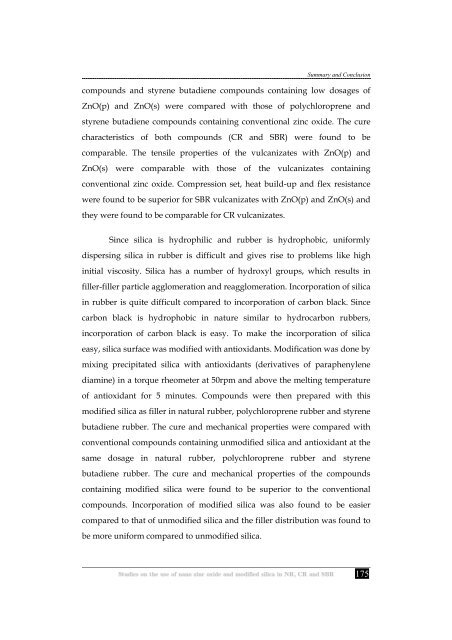Studies on the use of nano zinc oxide and modified silica in NR, CR ...
Studies on the use of nano zinc oxide and modified silica in NR, CR ...
Studies on the use of nano zinc oxide and modified silica in NR, CR ...
You also want an ePaper? Increase the reach of your titles
YUMPU automatically turns print PDFs into web optimized ePapers that Google loves.
Summary <strong>and</strong> C<strong>on</strong>clusi<strong>on</strong><br />
compounds <strong>and</strong> styrene butadiene compounds c<strong>on</strong>ta<strong>in</strong><strong>in</strong>g low dosages <strong>of</strong><br />
ZnO(p) <strong>and</strong> ZnO(s) were compared with those <strong>of</strong> polychloroprene <strong>and</strong><br />
styrene butadiene compounds c<strong>on</strong>ta<strong>in</strong><strong>in</strong>g c<strong>on</strong>venti<strong>on</strong>al <strong>z<strong>in</strong>c</strong> <strong>oxide</strong>. The cure<br />
characteristics <strong>of</strong> both compounds (<strong>CR</strong> <strong>and</strong> SBR) were found to be<br />
comparable. The tensile properties <strong>of</strong> <strong>the</strong> vulcanizates with ZnO(p) <strong>and</strong><br />
ZnO(s) were comparable with those <strong>of</strong> <strong>the</strong> vulcanizates c<strong>on</strong>ta<strong>in</strong><strong>in</strong>g<br />
c<strong>on</strong>venti<strong>on</strong>al <strong>z<strong>in</strong>c</strong> <strong>oxide</strong>. Compressi<strong>on</strong> set, heat build-up <strong>and</strong> flex resistance<br />
were found to be superior for SBR vulcanizates with ZnO(p) <strong>and</strong> ZnO(s) <strong>and</strong><br />
<strong>the</strong>y were found to be comparable for <strong>CR</strong> vulcanizates.<br />
S<strong>in</strong>ce <strong>silica</strong> is hydrophilic <strong>and</strong> rubber is hydrophobic, uniformly<br />
dispers<strong>in</strong>g <strong>silica</strong> <strong>in</strong> rubber is difficult <strong>and</strong> gives rise to problems like high<br />
<strong>in</strong>itial viscosity. Silica has a number <strong>of</strong> hydroxyl groups, which results <strong>in</strong><br />
filler-filler particle agglomerati<strong>on</strong> <strong>and</strong> reagglomerati<strong>on</strong>. Incorporati<strong>on</strong> <strong>of</strong> <strong>silica</strong><br />
<strong>in</strong> rubber is quite difficult compared to <strong>in</strong>corporati<strong>on</strong> <strong>of</strong> carb<strong>on</strong> black. S<strong>in</strong>ce<br />
carb<strong>on</strong> black is hydrophobic <strong>in</strong> nature similar to hydrocarb<strong>on</strong> rubbers,<br />
<strong>in</strong>corporati<strong>on</strong> <strong>of</strong> carb<strong>on</strong> black is easy. To make <strong>the</strong> <strong>in</strong>corporati<strong>on</strong> <strong>of</strong> <strong>silica</strong><br />
easy, <strong>silica</strong> surface was <strong>modified</strong> with antioxidants. Modificati<strong>on</strong> was d<strong>on</strong>e by<br />
mix<strong>in</strong>g precipitated <strong>silica</strong> with antioxidants (derivatives <strong>of</strong> paraphenylene<br />
diam<strong>in</strong>e) <strong>in</strong> a torque rheometer at 50rpm <strong>and</strong> above <strong>the</strong> melt<strong>in</strong>g temperature<br />
<strong>of</strong> antioxidant for 5 m<strong>in</strong>utes. Compounds were <strong>the</strong>n prepared with this<br />
<strong>modified</strong> <strong>silica</strong> as filler <strong>in</strong> natural rubber, polychloroprene rubber <strong>and</strong> styrene<br />
butadiene rubber. The cure <strong>and</strong> mechanical properties were compared with<br />
c<strong>on</strong>venti<strong>on</strong>al compounds c<strong>on</strong>ta<strong>in</strong><strong>in</strong>g un<strong>modified</strong> <strong>silica</strong> <strong>and</strong> antioxidant at <strong>the</strong><br />
same dosage <strong>in</strong> natural rubber, polychloroprene rubber <strong>and</strong> styrene<br />
butadiene rubber. The cure <strong>and</strong> mechanical properties <strong>of</strong> <strong>the</strong> compounds<br />
c<strong>on</strong>ta<strong>in</strong><strong>in</strong>g <strong>modified</strong> <strong>silica</strong> were found to be superior to <strong>the</strong> c<strong>on</strong>venti<strong>on</strong>al<br />
compounds. Incorporati<strong>on</strong> <strong>of</strong> <strong>modified</strong> <strong>silica</strong> was also found to be easier<br />
compared to that <strong>of</strong> un<strong>modified</strong> <strong>silica</strong> <strong>and</strong> <strong>the</strong> filler distributi<strong>on</strong> was found to<br />
be more uniform compared to un<strong>modified</strong> <strong>silica</strong>.<br />
175

















